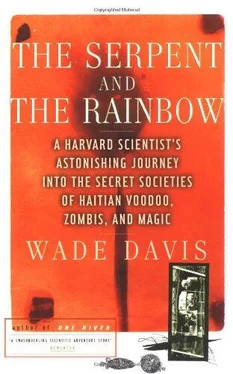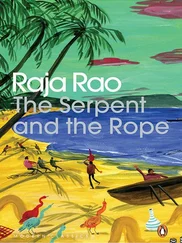Wade Davis - The Serpent and the Rainbow
Здесь есть возможность читать онлайн «Wade Davis - The Serpent and the Rainbow» весь текст электронной книги совершенно бесплатно (целиком полную версию без сокращений). В некоторых случаях можно слушать аудио, скачать через торрент в формате fb2 и присутствует краткое содержание. Год выпуска: 1985, Издательство: Simon & Schuster, Жанр: Старинная литература, на английском языке. Описание произведения, (предисловие) а так же отзывы посетителей доступны на портале библиотеки ЛибКат.
- Название:The Serpent and the Rainbow
- Автор:
- Издательство:Simon & Schuster
- Жанр:
- Год:1985
- ISBN:нет данных
- Рейтинг книги:5 / 5. Голосов: 1
-
Избранное:Добавить в избранное
- Отзывы:
-
Ваша оценка:
- 100
- 1
- 2
- 3
- 4
- 5
The Serpent and the Rainbow: краткое содержание, описание и аннотация
Предлагаем к чтению аннотацию, описание, краткое содержание или предисловие (зависит от того, что написал сам автор книги «The Serpent and the Rainbow»). Если вы не нашли необходимую информацию о книге — напишите в комментариях, мы постараемся отыскать её.
The Serpent and the Rainbow — читать онлайн бесплатно полную книгу (весь текст) целиком
Ниже представлен текст книги, разбитый по страницам. Система сохранения места последней прочитанной страницы, позволяет с удобством читать онлайн бесплатно книгу «The Serpent and the Rainbow», без необходимости каждый раз заново искать на чём Вы остановились. Поставьте закладку, и сможете в любой момент перейти на страницу, на которой закончили чтение.
Интервал:
Закладка:
“How do you mean?”
“I mean the puffers.” He rattled off a list of scientific names that meant nothing to me.
“What do they have in them?”
“Good Lord, I thought you people were drug experts. Not very up on your literature, either.” I must have looked confused. “James Bond. Last scene in From Russia with Love , one of the great moments in ichthyotoxicology. British agent double-oh-seven utterly helpless, paralyzed and unconscious after a minute wound from a hidden knife.” He stood up and perused his bookshelf, somehow managing to look scholarly even as he pulled the small paperback from between the thick rows of anonymous journals.
“Knew it was here somewhere. Here you go.” He quoted: “‘The boot with its tiny steel tongue flashed out. Bond felt a sharp pain in his right calf…. Numbness was creeping up Bond’s body…. Breathing became difficult…. Bond pivoted slowly on his heel and crashed to the wine-red floor.’” He returned the paperback to the bookshelf. “Double-oh-seven never had a chance,” he lamented. “Terribly clever of Fleming, too. You have to read the next book to find out. The blade was poisoned with tetrodotoxin,” he confided. “He tells you in the first chapter of Dr. No.”
“What is it?”
“A nerve toxin,” he replied, “and there is nothing stronger.”
It didn’t take me long to realize that the original hunch of Kline and Lehman had proved correct: the zombi poison included one of the most toxic substances known from nature. Marcel had recognized two varieties of fish—the fou-fou , which was Diodon hystrix , and the crapaud de mer, or sea toad, which was Sphoeroides testudineus . In English we know these as blowfish or puffer fish because of their ability to swallow large amounts of water when threatened, and thus assume a globular shape, making it more difficult for their predators to swallow them. One would hardly think such a passive defensive mechanism necessary. Both creatures belong to a large pan-tropical order of fish, many of which have tetrodotoxin in their skin, liver, ovaries, and intestines. This deadly neurotoxin is one of the most poisonous nonprotein substances known. Laboratory studies have shown it to be 160,000 times more potent than cocaine. As a poison it is, at a conservative estimate, five hundred times stronger than cyanide. A single lethal dose of the pure toxin would be about the amount that would rest on the head of a pin.
Tetrodotoxin’s role in human history reaches literally to the dawn of civilization. The Egyptians knew of the poison almost five thousand years ago; a figure of a puffer fish appears on the tomb of Ti, one of the pharaohs of the Fifth Dynasty. The deadly Red Sea puffer was the reason for the biblical injunction against eating scaleless fish that appears in the Book of Deuteronomy. In China the toxicity of the fish is acknowledged in the Pentsao Chin , the first of the great pharmacopeia, supposedly written during the reign of the mythical Emperor Shun Nung (2838 B.C.-2698 B.C.). In the East there is a continuous record that reflects an increasingly sophisticated knowledge of the biology and toxicology of the fish. By the time of the Han Dynasty (202 B.C.-A.D. 220), it was recognized that the toxin was concentrated in the liver; four hundred years later, during the Sui Dynasty, an accurate account of the toxicity of the liver, eggs, and ovaries appears in a well-known medical treatise. The last of the Great Herbals , the Pentsao Kang Mu (A.D. 1596), recognizes that toxin levels vary in different species and that within any one species they may fluctuate seasonally. It also offers a succinct but vivid description of the results of eating the liver and eggs: “In the mouth they rot the tongue, if swallowed they rot the gut,” a condition that “no remedy can relieve.” This is but one of the injunctions mentioned in the herbal warning of the dangers of the fish. Yet the Pentsao Kang Mu also reveals an extraordinary development that had taken place in Mandarin society. Despite the obvious risks, by 1596 the fish had become something of a culinary delicacy. Several recipes describe in great detail methods of preparing and cooking the fish that are said to eliminate some of the toxin and render the flesh edible. One account suggested soaking the roe overnight in water; another heralded the delight of eating “salted eggs and marinated testes.” Just how much range of error these methods allowed is uncertain. The herbal also records a folk saying that remains popular to this day in China and Japan: “To throw away life, eat blowfish.”
The subtleties of safely preparing puffer fish were quite unknown to the first European explorers to reach the Orient, and as a result they have left some of the most vivid accounts of just what these toxins are capable of. During his second circumnavigational voyage, Captain James Cook ignored a warning from the two naturalists he had on board and ordered the liver and roe of a puffer dressed for his supper. Cook insisted that he had safely eaten the fish elsewhere in the Pacific, and then in the unassuming way of a captain in the Royal Navy, he invited the two naturalists to eat with him. Fortunately, the three men merely tasted the morsel. Nevertheless, between three and four in the morning they were “seized with an extraordinary weakness in all our limbs attended with a numbness or sensation like that caused by exposing one’s hands or feet to a fire after having been pinched much by frost.” Cook wrote, “I had almost lost the sense of feeling; nor could I distinguish between light and heavy bodies … a quart pot full of water and a feather being the same in my hand.” Cook and his naturalists were lucky. Two sailors on the Dutch brig Postilion rounding the Cape of Good Hope some seventy years later fared less well. This account is offered by the physician who arrived at the bodies not ten minutes after they had eaten the fish (a species of Diodon , as it turned out). The boatswain
lay between decks, and could not raise himself without the greatest exertion; his face was somewhat flushed; his eyes glistening, and pupils rather contracted; his mouth was open, and as the muscles of the pharynx were drawn together by cramp, the saliva flowed from it; the lips were tumid and somewhat blue; the forehead covered with perspiration; the pulse quick, small and intermittent. The patient was extremely uneasy and in great distress, but was still conscious. The state of the patient quickly assumed a paralytic form; his eyes became fixed in one direction; his breathing became difficult, and was accompanied with dilation of the nostrils; his face became pale and covered with cold perspiration; his lips livid; his consciousness and pulse failed; his rattling respiration finally ceased. The patient died scarcely 17 minutes after partaking of the liver of the fish.
The sailor’s partner suffered the same symptoms, except that he vomited several times, which made him feel momentarily relieved. He expressed some hope until “a single convulsive movement of the arms ensued, whereupon the pulse disappeared and the livid tongue was protruded from between the lips.” His death occurred about one minute after that of his shipmate.
While Cook and the rest of the Europeans were having their difficulties on the high seas, the Japanese had adopted the Chinese passion for the puffer fish and carried its preparation to the level of art. The ardor with which the Japanese consumed their fugu fish bewildered early European observers. Engelbert Kaempfer, a physician attached to the Dutch embassy in Nagasaki at the turn of the eighteenth century, noted that “the Japanese reckon [this] a very delicate fish, and they are fond of it, but the Head, Guts, bones and all the garbage must be thrown away, and the flesh carefully wash’d and clean’d before it is fit to eat. And yet many people die of it….” He also observed that the fish was so dangerous and yet so popular that the emperor had been obliged to issue a special decree forbidding his soldiers to eat it. Curiously, though Kaempfer seems to have witnessed many individuals eating and enjoying the puffer, he concludes, “the poison of this sort is absolutely mortal, no washing nor cleaning will take it off. It is therefore never asked for, but by those who intend to make away with themselves.” This Dutchman, like countless generations of Western visitors who came after him, missed the point of the puffer experience completely. As the Japanese explain in verse, “Those who eat fugu are stupid. But those who don’t eat fugu are also stupid.”
Читать дальшеИнтервал:
Закладка:
Похожие книги на «The Serpent and the Rainbow»
Представляем Вашему вниманию похожие книги на «The Serpent and the Rainbow» списком для выбора. Мы отобрали схожую по названию и смыслу литературу в надежде предоставить читателям больше вариантов отыскать новые, интересные, ещё непрочитанные произведения.
Обсуждение, отзывы о книге «The Serpent and the Rainbow» и просто собственные мнения читателей. Оставьте ваши комментарии, напишите, что Вы думаете о произведении, его смысле или главных героях. Укажите что конкретно понравилось, а что нет, и почему Вы так считаете.












